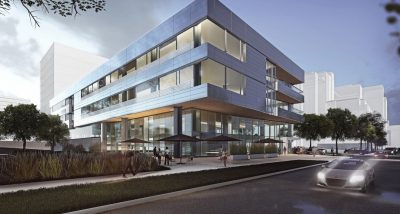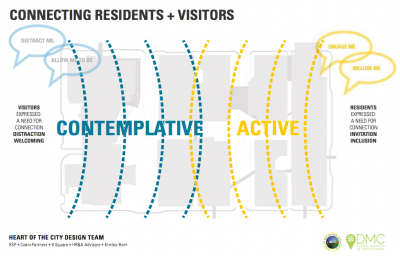With all the activity taking place in the Destination Medical Center (DMC) District, the recent DMC Corporation Board of Directors meeting agenda was a full one and included updates on DMC’s top development priorities, such as Discovery Square and Heart of the City.
Financial update
At the end of 2016, private investment in the DMC district surpassed $200 million, the threshold required to trigger the release of State dollars to support Rochester’s infrastructure needs. It was reported at the meeting that the Minnesota Department of Employment and Economic Development (DEED) certified the report and has authorized the release of $2.6 million of the state money for local infrastructure improvements by September.
“This is the reason we’ve been doing this for the past several years,” says DMCC board vice-chair R.T. Rybak. “I encourage the staff to take time to celebrate this achievement.”
Discovery Square Developments
One of six DMC sub-districts, Discovery Square will be a live-work environment organized around attracting and retaining the best and brightest to our community. While there is progress taking place in all of six sub-districts, Discovery Square is a board-identified priority for DMC, as are Heart of the City and transportation.
Construction activity in Discovery Square, specifically in the residential, restaurant, retail and high-tech industries, has been steady and will continue to increase as additional plans for the 16-block sub-district unfold. Plans for a proposed child care center and additional retail are already underway.
 The signature new building in Discovery Square is the Mortenson “Phase 1” development to be built at the corner of 4th Street and 2nd Avenue SW. “The building will be a catalyst for future life science development in Rochester,” says Patrick Seeb, DMC EDA director of economic development and placemaking. The four-story, 89,000 square foot building, with a foundation rooted in collaboration, includes lab, office, retail, and public gathering spaces and boasts “ambitious sustainability and energy standards.”
The signature new building in Discovery Square is the Mortenson “Phase 1” development to be built at the corner of 4th Street and 2nd Avenue SW. “The building will be a catalyst for future life science development in Rochester,” says Patrick Seeb, DMC EDA director of economic development and placemaking. The four-story, 89,000 square foot building, with a foundation rooted in collaboration, includes lab, office, retail, and public gathering spaces and boasts “ambitious sustainability and energy standards.”
The $35 million Mortenson project received unanimous approval from the DMCC board. The board also agreed to $4.9 million in tax-increment financing for the developer, making the Discovery Square project the fourth to receive DMC financing. Tax-increment financing allows a developer to receive future new tax revenue to move the project forward in exchange for the public value it will provide once it’s operational. In the case of the Mortenson project, property taxes for the space will increase from $68,000 to an estimated $485,000 annually, ultimately benefiting the community both for its financial return as well as its potential to advance medicine, technology, education through collaboration. Seeb says the project will also create 325 permanent jobs and around 500 short-term jobs.
Mortenson development executive Jeremy Jacobs told the board that the project has taken a village to get to its current status. “It’s been a series of leaps of faith,” Jacobs says. “We are building this in a market that doesn’t yet exist and we feel really good about where we are with it today.”
Heart of the City Progress
Plans to advance the Heart of the City sub-district continue to evolve and the team from RSP Architects shared an update with the board to keep them abreast of the developments taking place in Rochester’s core sub-district.
The Heart of the City Design Team includes RSP, Coen+Partners, 9.Square, HR&A Advisors, and Kimley-Horn. Their mission is to “create a vibrant, world class urban downtown that is uniquely Rochester – to attract residents and visitors to the Heart of the City – a place that celebrates life, community, health, and wellness 365 days a year.”
Mayor Brede informed meeting attendees that he will soon be traveling to New Orleans to visit the Orpheum Theatre, which has been fitted with an adjustable floor like the floor suggested for the Chateau Theatre. Multiple board members emphasized the importance of capitalizing on the Chateau renovation and the engagement of downtown property owners to bring the vision of Heart of the City to life.
“They [adjacent property owners] have a critical role in helping us get this done,” said board member Jim Campbell.
RSP Architects principal Jon Buggy reported that the firm is completing the schematic design and described the benefits of investment in public space. “Open spaces encourage people to extend their visit,” said Buggy. He went on to explain that investing public dollars to create a destination often catalyzes economic development spurring 200-300% return in private investments, benefiting the entire community.
The Heart of the City design process focused on several elements: Second Avenue; First Avenue and the alleys; Peace Plaza; Theatre Square; and public art. Redesigned public space near the Gonda Building will foster a better connection between the building and Peace Plaza. First Avenue will remain open to traffic but will be the first curb-less street in Minnesota.
Four participants from 2016’s PlaceMakers prototyping festival are also engaged in the design process. The alley will be activated through use of projection technology to share images. Peace Plaza may be divided by a central row of trees and pop-up vendor areas making the adjacent brick-and-mortar shops more accessible.
Art will also be a central feature of the public space, with a goal of creating collaboration between locally- and nationally-renowned artists. Some world-renowned artists, like James Turrell, have also expressed interest in the Heart of the City.
“Now is the time to be aspirational—and you’ve done it,” said Campbell. “It feels very, very good.”


